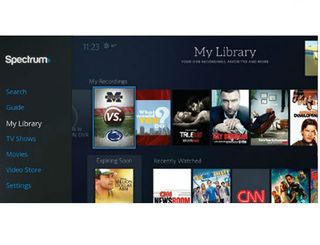Charter Expands Rollout of Cloud-Powered ‘Spectrum Guide’

Charter Communications has expanded the rollout of Spectrum Guide, its cloud-based user interface that relies on ActiveVideo technology to deliver it to older QAM-locked set-tops as well as its newer IP-capable devices.
Charter said it has introduced Spectrum Guide to video subs in Fort Worth, Texas; Reno, Nev.; and St. Louis, Mo., and that it will soon start to launch its new World Box, a platform that will support the new UI, an array of apps, and feature a downloadable security platform. Technicolor, which acquired Cisco Systems’ CPE business in November 2015, and Humax are the known suppliers of the World Box.
Speaking Thursday on Charter’s Q1 call, company CEO Tom Rutledge said the MSO expects to have the UI rolled out to most legacy Charter markets by the end of 2016.
“It continues to scale well, and is resonating with consumers,” he said.
He said managing the all-digital transition of the acquired systems will be a “key priority,” hopeful that Charter can complete the process across all 36 million homes passed by TWC and Bright House by the end of 2018. Charter is still working on the rollout plan of Spectrum Guide in the acquired systems, Rutledge said.
Early into the all-digital process after the deals close, Charter will “briefly pause” new digital rollouts in the legacy and newly acquired systems, and then restart the effort by deploying two-way set-tops everywhere, and discontinuing the deployment of one-way Digital Transport Adapters (DTAs), Rutledge said.
TWC has been using DTAs, which don’t inherently support two-way services like VOD, to help fuel its all-digital initiative. Charter will remove DTAs from the market “in a natural way” as new customers sign up for service and existing ones upgrade, Rutledge said. “We’re not going to force them out.”
Multichannel Newsletter
The smarter way to stay on top of the multichannel video marketplace. Sign up below.
On the call, Charter was also asked to discuss the advantage of the ActiveVideo joint venture with Arris (the J.V. acquired ActiveVideo in mid-2015, with Arris nabbing a 65% stake).
Charter EVP and CFO Chris Winfrey called it a “productive relationship,” noting that Charter is treated as an “independent third-party vendor inside the relationship with ActiveVideo” with the ability to see inside the product pipeline and have some oversight on product development.
“That ActiveVideo technology platform allows us to use existing set-top boxes and put a state-of-the-art user interface on those already deployed boxes and not have to replace those boxes, so that they essentially become state-of-the-art boxes,” Rutledge added. “That’s the capital advantage of having that vendor relationship.”
During the call, Rutledge also discussed some other operational efforts that are bearing fruit. In Q1, Charter saw a 15% year-on-year reduction in billing and service calls, and a 19% reduction in service truck roll volume. About 80% of service truck rolls at Charter are now insourced, up from 50% in 2012, he said, adding that call center activity is now 90% insourced.
In April, Charter added an electronic disconnect capability in lieu of physical truck rolls. That is also helping Charter to scale its self-install practices, Rutledge said.










